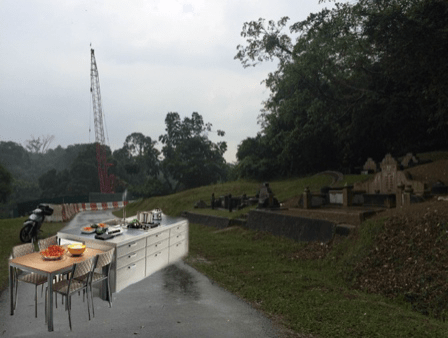III. SITE-SPECIFIC THEATRE: ARCHITECTURE, BODIES, AND PRESENCE
Drawing upon Hamlet’s obsession to speak with the dead, I began to think about how I would communicate these “defunct” ideas (that seem contextually outdated – not thematically but more so culturally and presentationally) from the Renaissance period in a way that would emphasise its relevance in a contemporary, Singaporean context. With the thematic issues explored in the previous section in mind, I started to think more about the potential setting and set design of Hamlet that would facilitate the exploration of the idea of Purgatory, the tension between the old and the new, and the notion of posthumous remembrance.
As such, I thought of doing a site-specific proposal for staging the play in Bukit Brown Cemetery, as it immediately seemed appropriate – a cemetery is a site of death, mourning, and memory. However, more importantly, the historical and political context of Bukit Brown is also very relevant to the thematic explorations of the play. Modernising the play by making it site-specific to Bukit Brown also adds depth to how those who reside in Singapore can understand local issues of land contestation, the state’s relationship with heritage (on both collective and personal levels) and find some connection to Shakespeare’s works. Through creating intention with regard to the setting of the play, Bukit Brown and Hamlet can hopefully act as mutually reinforcing foils that reveal nuances within each other.
Bukit Brown is a contested space in Singapore as it is targeted for land reclamation, but houses a large Pan-Chinese community, with some prominent figures who were important to the history of Singapore as a nation-state. Between the years 1965 to 2011, the Public Works Department and Land Transport Authority announced plans to construct roads that would cut through the cemetery and affect about 5,000 tombs. Since then, over 3,700 tombs have already been exhumed and the cemetery has been split into two to make way for the Pan Island Expressway. As can be seen from the figures below, parts of Bukit Brown are still undergoing construction (see Figures 1-2). In 2013 it was placed on the 2014 World Monuments Watch, which records global heritage sites that are at risk of being destroyed.



This chart above presents issues that are central to Bukit Brown and also related issues that the space symbolises. The point about the older generation being unable to assimilate is not directly related to Bukit Brown, but it is an effect of the same attitudes and practices that are threatening the cemetery: the fixation with urban redevelopment and progress. Looking at recent case studies, such as the Dakota Crescent and the Tanglin Halt relocation projects, the ageing population is being displaced from environments and communities that they are familiar with and have forged over time. It has created a lot of disorientation, threat to collective memory and physical heritage, and a sense of alienation.
This tension is similar to that of the dissonance between modern and traditional beliefs in Hamlet, as characterised by Hamlet and the Ghost. Additionally, on the note of unrest, the mass exhumation of graves, the dividing of cemetery landscape, and the coexisting motifs of construction (see Figure 3) transform Bukit Brown into a purgatorial space, in that the bodies are unable to truly be put to rest.

Source: Tam, Simone. Personal photo.
Tension Between Old and New: Taking into account the fact that Hamlet is set in a castle, it is clear that the urban set design of the play does not belong in the natural environment of Bukit Brown cemetery. In fact, these two domestic spaces are juxtaposed against the natural imagery of the cemetery and seem to be awkwardly placed amongst the graves and foliage (see Figures 4-5).


I intend on having this contrasting effect as it raises the question: is the old world (which Bukit Brown symbolizes) the world that is truly out of place? This is of a similar vein to the discourse surrounding Purgatory that Hamlet alludes to, which the device of the Ghost symbolizes. This directorial vision serves to further underscore the idea of preserving history and emphasizing the importance of memory in the wake of great – and perhaps inevitable – change. When memory persists, so do the dead. They are only truly gone when they fall out of memory completely – and perhaps that is the urgent point that King Hamlet was trying to raise.
FOOTNOTES
1 William Shakespeare, Hamlet, ed. Ann Thompson and Neil Taylor (London: The Arden Shakespeare, Bloomsbury Publishing, 2006), 3.1.55.
2 Hamlet, 3.4.100-101.
3 Peter Goldman. “Hamlet’s Ghost: A Review Article Greenblatt, Stephen. Hamlet in Purgatory. Princeton UP, 2001.” Anthropoetics: The Journal of Generative Anthropology 7, no. 1 (2001). http://anthropoetics.ucla.edu/
4 Ibid., 1.5.11-14.
5 Peter Goldman. “Hamlet’s Ghost: A Review Article Greenblatt, Stephen. Hamlet in Purgatory. Princeton UP, 2001.”
6 Ibid.
7 Antun Pavešković, “René Girard’s Fundamental Anthropology”, Collective Anthropology 41, no. 3 (2017): 310.
8 Hamlet, 1.5.82-83.
9 Ibid., 1.5.2.
10 Eric Gans, ”On Looking Into Branagh’s Hamlet,” Chronicles of Love and Resentment #141. Saturday, June 20th, 1998.
11 Hamlet, 1.2.133.
REFERENCES
Gans, Eric. ”On Looking Into Branagh’s Hamlet.” Chronicles of Love and Resentment #141. Saturday, June 20th, 1998.
Goldman, Peter. “Hamlet’s Ghost: A Review Article Greenblatt, Stephen. Hamlet in Purgatory. Princeton UP, 2001.” Anthropoetics: The Journal of Generative Anthropology 7, no. 1 (2001). http://anthropoetics.ucla.edu/
Pavešković, Antun. “René Girard’s Fundamental Anthropology”. Collective Anthropology 41, no. 3 (2017): 309-313.
Shakespeare, William. Hamlet. Edited by Ann Thompson and Neil Taylor, London: The Arden Shakespeare, Bloomsbury Publishing, 2006.

